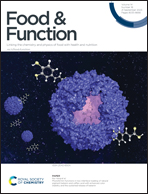Multiomics reveals the mechanism of B. longum in promoting the formation of mixed-species biofilms†
Abstract
It has been found previously that Bifidobacterium longum, Bacteroides ovatus, Enterococcus faecalis, and Lactobacillus gasseri can form a biofilm better when co-cultured in vitro and B. longum is the core biofilm-formation-promoting strain in this community. B. longum is part of the core microbiota in the gut and is widely recognized as a probiotic. Therefore, it is necessary to explore its role in mixed-species biofilms through transcriptomics and metabolomics. Metabolomics showed that the increase in amino acid and purine content could promote biofilm formation. In transcriptomic analysis, many genes related to carbohydrate metabolism, amino acid metabolism, and environmental tolerance of B. longum were up-regulated. Combined with the Kyoto Encyclopedia of Genes and Genomes (KEGG) pathway analysis and Gene Ontology (GO) analysis, the differentially expressed genes (DEGs) of B. longum in mixed-species biofilms were mainly correlated to “quorum sensing (QS)”, “ABC transporters”, “biosynthesis of amino acids”, “microbial metabolism in different environments”, “carbohydrate metabolism” and “two-component system”. In addition, the rpl and rps gene families, which function in the metabolism of organic substances and the biosynthesis of amino acids, were the core DEGs according to the analysis of the protein–protein interaction (PPI) network. Finally, by combining metabolomics and quorum sensing mechanisms, it was found that the metabolism of autoinducer peptides (proliylglycine and glycylleucine), N-acyl homoserine lactone (N-(3-oxo hydroxy) homoserine lactone), and AI-2 can promote the formation of biofilms, both mono- and mixed-species biofilms composed of B. longum. Our research enabled us to understand the critical role of B. longum in mixed-species biofilms and the interactions between biofilm metabolism and gut health. In addition, the generated knowledge will be of great significance for us to develop biofilm products with beneficial functions in future.



 Please wait while we load your content...
Please wait while we load your content...